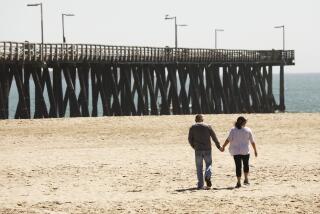Japan Hunts Gas Attack Suspects : Crime: Premier orders an all-out effort after eight are killed, thousands injured in Tokyo subway. Organized group believed responsible and suspect is reported held.
- Share via
TOKYO — Prime Minister Tomiichi Murayama ordered an all-out effort Monday to apprehend whoever released a deadly gas in the subway system here, killing eight people and afflicting nearly 4,700 rush-hour commuters in an unprecedented case of urban terrorism that has stunned this law-abiding nation.
“Such indiscriminate killings must not be tolerated,” Murayama declared, as 330 police officers joined firefighters and chemical experts of the Self-Defense Forces.
The Tokyo Shimbun reported that one suspect was under guard at a Tokyo hospital but was too ill to be interrogated by police. The newspaper reported that a man in his 30s or 40s was chased by passengers after being seen leaving a plastic bag wrapped in newspapers and trying to get off at Kodenmacho station on the Hibiya subway line. But the man and his pursuers all collapsed from the fumes and were taken to an unidentified hospital, the newspaper said. Police officials refused to confirm or deny the report.
Evidence mounted that the attacks were deliberately planned acts of terrorism by an organized group. Police said that six incidents occurred within 43 minutes, that one person could not have been responsible for all of them, and that after checking train schedules they concluded that three to five people must have taken part in releasing the deadly gas.
Patrols were strengthened and security tightened on all rail and subway lines, as station personnel checked trains and trash cans for suspicious-looking packages.
Police confirmed that the poison used in the attacks was sarin, a nerve gas first developed by Nazi Germany in the 1930s.
The volatile toxin cripples the nervous system and paralyzes breathing and cardiac functions; a drop can kill a person within minutes. It is thought to have been used for the first time by Iraq in 1988 against Kurdish rebels.
The poison is believed to have leaked out of broken bottles and boxes wrapped in newspapers left inside five trains and at one station.
The fumes caused scores of commuters to collapse in pain, to vomit and to suffer severe coughing attacks, breathing difficulties and nosebleeds. Most victims also reported that their vision diminished, as the gas caused pupils to contract.
At least 75 people were reported in critical condition, 46 were in serious condition and 113 hospitals treated more than 4,000 others.
Although most of the afflicted returned home after receiving oxygen and injections, officials warned that the symptoms could worsen after 24 hours. The poison is known to have lingering aftereffects such as respiratory problems; recovery from miosis, or abnormal pupil contraction, can take weeks or even months.
About 1.1 million commuters were inconvenienced as the three affected subway lines shut down for most or all of the day Monday. Service was expected to return to normal today.
No group claimed responsibility for the attacks.
But in response to widespread rumors of involvement, the Aum Supreme Truth religious group denied in a statement issued Monday that its members had planted the poison. The group said the attack was a carefully designed plot to discredit its religious activities.
Suspicion centered on the group--which describes itself as adhering to “primitive Buddhism and yoga” but which critics say is a radical cult--after police in July detected sarin around a building it owns in Yamanashi prefecture (state) about 65 miles west of Tokyo. The previous year, residents had complained of a strange odor being emitted from an Aum compound in Tokyo. The group, however, sued a local firm in January for allegedly placing the poison around the building in Yamanashi.
After police arrested three Aum members Sunday for allegedly kidnaping a youth trying to escape the group, speculation grew that the poison attacks were an act of revenge.
The group was established in 1984 and has 10,000 members in Japan and 20,000 members in Russia. It is known to confiscate property of all members, require communal living and restrict contact with family or friends.
Crime experts said they did not believe Monday’s subway attack was the work of extremist political groups because no political message was delivered.
“If they were against government authority, they might have delivered a statement after it happened,” said Koyu Iwai, professor emeritus of criminal psychology at Toyo University. “So maybe they were just trying to attract attention.”
But others noted that all three subway lines affected--the Hibiya, Marunouchi and Chiyoda lines--intersect at Kasumigaseki, the heart of Japan’s government where all the central ministries are located. “Something is targeting Kasumigaseki--the nerve center of Japan,” said Hiroshi Kume, a popular newscaster for TV Asahi.
The random nature of the crime, and the coldly calculated way in which it was carried out, shocked and angered people here.
“I thought Japan was a safe country,” one woman at the Ebisu train station told Japanese television. “It’s really awful for us to see this kind of incident take place.”
One man noted of the crime: “It’s frightening and intolerable. I can’t believe it.”
Kozo Igarashi, chief Cabinet spokesman, said the victims would probably receive some government compensation.
Emergency workers in protective masks and suits, along with chemical experts from the Self-Defense Forces, labored to clean poisons from 16 stations affected. By nightfall, the Marunouchi and Chiyoda lines had reopened, except for Kasumigaseki station. The Hibiya line remained closed, however, and station personnel posted a sign on the shuttered entrance: “Guerrilla Incident Occurred. Out of Service.”
Afternoon classes in 17 elementary, middle and high schools in central Tokyo were canceled and students sent home after being counseled and given face masks.
Deadly fumes were first reported shortly after 8 a.m. in Tsukiji, location of Tokyo’s largest fish market, along the Hibiya subway line. Passengers reported seeing a man in his 30s or 40s, wearing sunglasses and a flu mask, place a box wrapped in newspapers near the train door at Kamiyacho station.
Authorities also reported that similar packages or bottles were found at four other sites. At Kasumigaseki, deputy station master Kazumasa Takahashi found a box wrapped in newspaper leaking liquid and removed it with his hands shortly after 8 a.m. He was pronounced dead by 9:23 a.m.
Officials are investigating links to three other poison gas incidents in the last year. Last June, sarin was released in a neighborhood in Matsumoto in Nagano prefecture about 100 miles northwest of Tokyo, killing seven people and sending more than 200 to hospitals for treatment. One month later, the traces of sarin were found in Yamanashi prefecture.
On March 5, an unidentified colorless gas was released on the Keihin Kyuko train line in Yokohama. Nineteen people suffered coughing fits, nausea and other afflictions.
No one has ever stepped forward to claim responsibility for these previous attacks, police said.
Sarin--also known as “German B” or “GB”--is one of the most poisonous warfare agents ever produced, experts say. It was developed in 1938 by the German chemist Gerhard Schrader; the Nazis produced it later during World War II but never used it.
Sarin, which blocks an enzyme vital for transmission of nerve impulses, is a nearly odorless yellow-brown fluid, experts say.
Times staff writer Mary Williams Walsh in Berlin contributed to this report.
More to Read
Sign up for Essential California
The most important California stories and recommendations in your inbox every morning.
You may occasionally receive promotional content from the Los Angeles Times.














